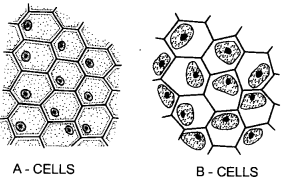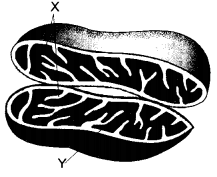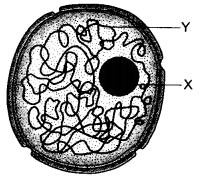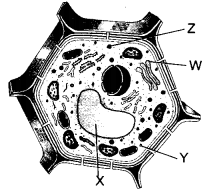Class 9 Science Chapter 5 HOTS Questions - The Fundamental Unit of Life
Q1: What will happen if chloroplast is taken out of the cell and illuminated ?
Ans: Chloroplasts are semi-autonomous cell organelles that can perform photosynthesis when illuminated. If a chloroplast is taken out of the cell and kept in an isotonic medium, it can still function effectively. To carry out photosynthesis, the chloroplast must receive the necessary raw materials, particularly carbon dioxide.
Q2:
- Identify A and B cells.

- What will happen if B cells are kept in hypotonic solution ?
- What will happen if A cells are kept in hypertonic solution ?
Ans:
- A cells- Turgid cells. B cells- Plasmolysed cells.
- B cells kept in hypotonic solution will become deplasmolysed if done so immediately after plasmolysis.
- A cells kept in hypertonic solution will become plasmolysed.
Q3:
- Label X and Y

- What is the function of X ?
What is the composition of Y? - Identify the above diagram and what is its common name ?
Ans:
- X-crista. Y-matrix.
- Function of X. Increases surface area of inner membrane for ATP synthesis.
- Mitochondrion (cut lengthwise). Common Name. Power house of cell.
Q4:
- Identify the above figure.

- Label X and Y
- What is the function of X?
Ans:
- It is figure of Nucleus.
- X- Nucleous.Y-Chromatin.
- Function of X. Synthesis of ribosomes.
Q5: What will happen if
- Excess amount of fertiliser is added to green grass lawn.
- Salt is added to cut pieces of raw mango ?
Ans:
- Excess Fertiliser. It will kill grass plants due to exosmosis and plasmolysis.
- Salt to mango pieces. It will cause exosmosis. Salt also protects the cut pieces from bacterial and fungal attack.
Q6.
- Label W, X, Y and Z.

- What is the covering membrane of X known as ?
- Which of them contains hydrolytic enzymes ?
- Which one of them takes part in storage, modification and packaging of various chemicals.
Ans:
- W-Golgi apparatatus. X-Vacuole. Y-Ribosomes. Z-Lysosome.
- Covering membrane of X. Tonoplast.
- Hydrolytic Enzymes. Lysosome.
- Storage, Modification and Packaging. Golgi apparatus.
Q7: If cells of onion peel and RBC are separately kept in hypotonic solution, what will happen to each of them? Explain the reason for your answer.
(a) Both the cells will swell.
(b) RBC will burst easily while cells of onion peel will resist the bursting to some extent.
(c) (a) and (b) both are correct.
(d) RBC and onion peel cells will behave similarly.
Ans: (b)
When kept in a hypotonic solution, the onion cells will become turgid because the water will enter the cell due to osmosis. But the cell wall present outside the cell provides it rigidity and does not let any harm to occur.
Whereas, in RBC the movement of water inside the cell due to osmosis will lead to bursting of the cell because it does not have a rigid cell wall.
Therefore RBC will burst easily while onion cell peels will resist it to some extent.
Q8: Where will you find more number of ribosomes-in cancer cells or in fat cells?
Ans: Ribosomes are found in greater numbers in actively dividing cells, such as cancer cells, as these cells require a larger amount of proteins for the formation of new cells.
Q9: A person takes concentrated solution of salt, after sometime, he starts vomiting. What is the phenomenon responsible for such situation? Explain.
Ans: Concentrated salt solution is a hypertonic solution. This causes exosmosis in the cells of the alimentary tract. This further results into dehydration and irritation thus resulting in vomiting.
Q10: What are the colours absorbed by plants? The green light of the sunlight is blocked. How will the photosynthesis be affected?
Ans: Plants absorb various colours in the light spectrum, primarily red and blue wavelengths, while they reflect green light, which is why they appear green. If green light is blocked, photosynthesis will not be adversely affected, as plants can still utilise other wavelengths for this essential process.
Q11: A solution of 3% glucose and a solution of 8% glucose are kept in a trough separated by a semipermeable membrane. What will you observe after 1 hour?
Ans: After 1 hour, the solutions on both sides of the semipermeable membrane will become isotonic. This occurs due to the process of osmosis, where water molecules move through the membrane from an area of lower solute concentration (3% glucose) to an area of higher solute concentration (8% glucose) until equilibrium is achieved.
Q12: Why does the skin of your finger shrink when you wash clothes for a long time?
Ans: Soap solution is a hypertonic solution. When our fingers are in contact with it for a long time, water from epidermal cells of fingers diffuse out through the process of osmosis and the skin shrinks.
|
84 videos|478 docs|60 tests
|
FAQs on Class 9 Science Chapter 5 HOTS Questions - The Fundamental Unit of Life
| 1. What are the main components of a cell? |  |
| 2. What is the difference between prokaryotic and eukaryotic cells? |  |
| 3. How do cells obtain energy? |  |
| 4. What is the function of the cell membrane? |  |
| 5. Why are cells considered the fundamental unit of life? |  |
















